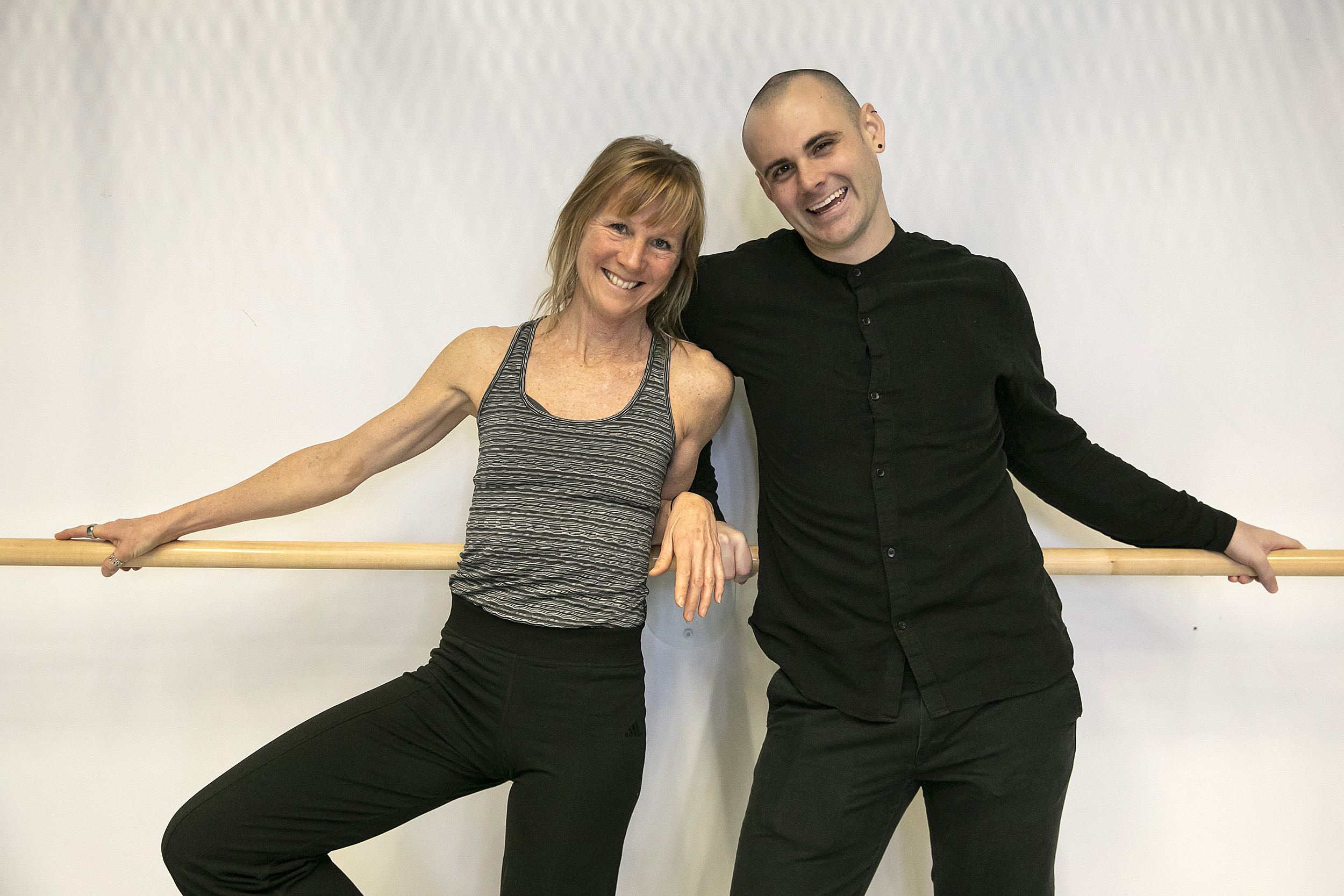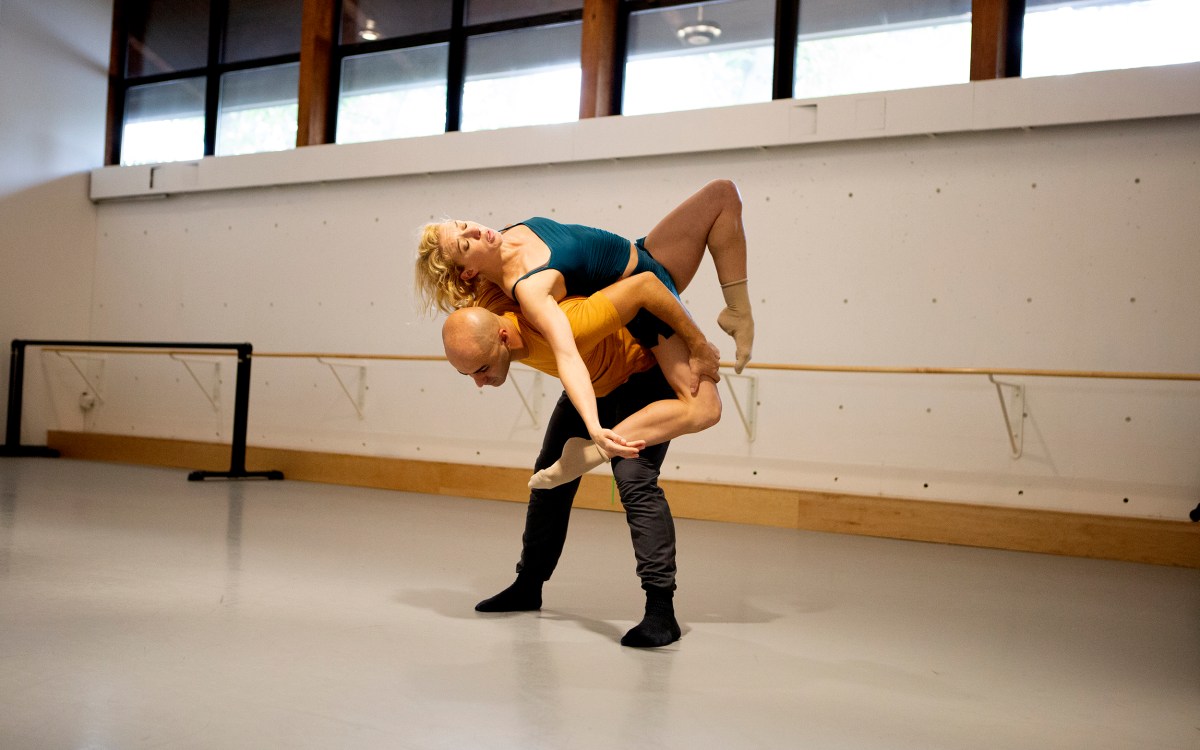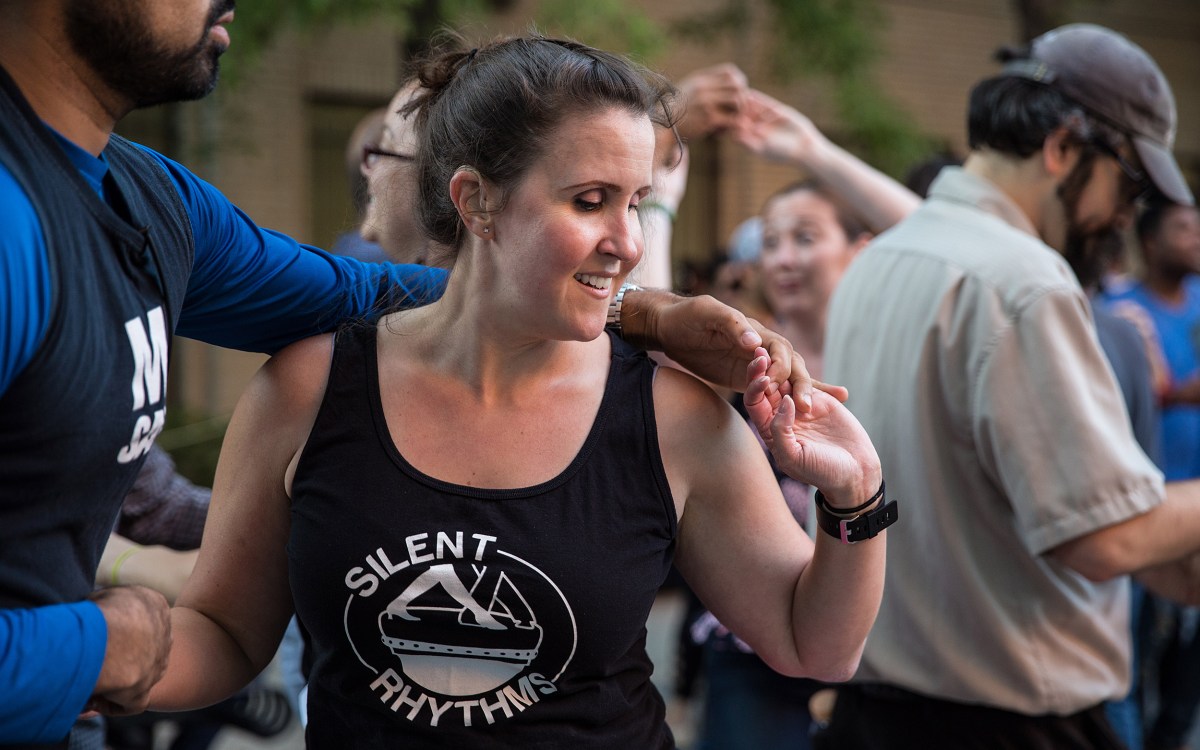Flowing together
Video by Meredith Slifkin and Joshua Lee
With twisting and floating movements, Harvard Gaga dance course teaches students and community members to listen to their bodies
Among the many things you should know about the Gaga dance technique, perhaps the most important is that Gaga the dance has nothing to do with Gaga the Lady.
It does have to do with movement — pure, uninhibited, and ever-flowing. Gaga dancers twist, wiggle, bend, stretch, fall, jump, and “float,” each move building on another and helping performers discover their bodies’ strengths and weaknesses. Developed by Israeli choreographer Ohad Naharin, Gaga is a movement language intended to help practitioners raise physical awareness by focusing on (or in Gaga terms, “listening” to) the rhythm of their bodies, letting them direct their movement and the pleasure that movement brings.
Gaga performers adhere to various codes and rules. There are no mirrors. There are no observers. There is no choreography. Gaga isn’t intended to be viewed. Some performers don’t even know what they look like when they dance Gaga.
For many around the world, Gaga is seen as a way of expressing yourself through your own range of unique, improvised movements. It’s a toolbox to expand people’s boundaries on how they can move their bodies and improve on them. It works for dancers, for nondancers, and even for those pretending to be dancers — in training for her Academy Award–winning role as a prima ballerina in “Black Swan,” Natalie Portman practiced the technique to hone her skills.
At Harvard, both introductory and advanced Gaga courses are offered, and those who’ve taken them have found the technique helps them let go of external pressures and learn to focus their energy inward, achieving self-care and healing.
“It’s a sense of letting everything drop away,” said Amy Thornton, a master’s student at the Harvard Graduate School of Design. She is taking her first Gaga class this semester. “It’s like a meditation but very different. You’re letting everything in your life drop away so you can feel an energy that feels like it’s emanating from your core. Your body flows from that energy.”
“Connect to the seaweed quality of your spine. Try not to take your focus somewhere else. Stay inside your body. You’re opening the passages of movement.”
“Gaga is a return to innocence,” added Mario Alberto Zambrano, a lecturer in Theater, Dance & Media. “It’s all about sensation and letting the body tell you what to do. It’s about going beyond what you think is right or wrong and just doing it.”
Zambrano, who has worked in the performing arts for 30 years and trained in Gaga at Israel’s Batsheva Dance Company with its founder, Naharin, teaches both Gaga courses at Harvard. In them, he tries to move students past trying to do Gaga right or simply imitating his own movements, instead getting them into their own bodies and their own unique rhythms, he said. In short, Zambrano tries to get students to think and feel movement as a sort of energy coursing through the entire body, continuous and unimpeded.
Aesthetically, Gaga can look like tai chi or yoga at times, but without the mannequin-like positioning or the strict movements or form that define most dance techniques. “In other traditional or conventional techniques, the form is the primary attention,” Zambrano said. “The focus is directly to the form. That’s what you’re trying to execute, this clarity or specificity of what every movement is. In Gaga, it flips things upside down. It’s about the flow of movement that already exists in the body and giving into it. You want to allow movement to pass through so that there’s a constant circulation of energy rather than aggressive places in the body where there isn’t any movement.”
With that goal in mind, Zambrano began a recent class by dimming the lights inside a gray-floored studio at the Harvard Dance Center and walking to its center. About 20 dancers rose from their warm-up stretches and circled around him. “Move like you have plenty of time,” said Zambrano, whose body now seemed loose and free, as if he were floating in water. “You need to open the passages to let the movement in.”

Harvard Dance Project performs Ohad Naharin’s “Echad Mi Yodea” at Farkas Hall.
Courtesy of Liza Voll
Zambrano’s instructions often came in the form of metaphors rather than explicit direction.
“Collapse your pelvis,” he said in a tranquil tone. The students squatted slightly. “Soften your knees and your ankles.” The students went lower, loosening their stance. “Connect to the seaweed quality of your spine,” he told them. “Try not to take your focus somewhere else. Stay inside your body. You’re opening the passages of movement.”
As a rule, the one-hour class goes continuously from start to finish without water or rest breaks. Some movements are easy and slow; others intense and quick, with dancers starting on one side of the room and jumping to the other. There’s plenty of sweat after each class. Like many workouts, however, it’s worth it both physically and mentally.
“Once you’re done with class, you feel like an empty vessel,” Thornton said. “You feel like a more beautiful, whole person.”
That’s part of the healing that happens in Gaga. The class is a break from the usual grind of everyday life. It gives its students like Harvard Divinity School master’s candidate Eric Busse a stress-free environment for physical and mental wellness.
“I was just really taken aback how in that room was the most free that I had seen anyone since coming to Harvard,” said Busse, who has trained in other dance methods. “I’ve never experienced a training method that at the outset completely says this is not about what you look like, or what you think you look like, or what you think others think you look like. This is about you getting clear about your interior experience and how information flows within that interior experience.”
Gaga dancers Eric Busse and Amy Thornton.
Jon Chase/Harvard Staff Photographer

Harper Gordon ’20 took Gaga as a way to heal after going through a difficult time with her family. The Crimson Dance team captain concentrating in human development and regenerative biology almost didn’t return this academic year. Gaga gave her an outlet to focus on self-care.
“It became my space during the week to only think about myself and my body and dancing and nothing else,” Gordon said. “I’m realizing more and more that it’s becoming physical therapy for my mental self. It’s also a lot of fun!”
It’s telling that these students found healing through Gaga. After all, it’s how the dance was born. Naharin, its founder, developed the form to keep in tune with his body as he recovered from a back injury about 20 years ago. Soon it became one of the main training methods at the Batsheva center in Tel Aviv, where he is artistic director.
Gaga has grown a lot in practice and popularity. The technique is offered in two educational tracks: “Gaga/people” is open to anyone over the age of 16, while its more advanced counterpart, “Gaga/dancers,” is meant for those with previous dance experience.
Whatever a dancer’s level, everyone seems to use metaphors, saying they’re moving like spaghetti boiling in water or feeling the collapse between their ears and throwing around words like “groove” and “yo-yo.” Such terms are embraced as part of the philosophy behind Gaga; for instance, not being defined by gravity has both the literal meaning of not letting your body feel weighed down, and also the figurative meaning of not letting bad habits or thoughts weigh down your mind. For Gordon, that and the concept of floating and shaking have been particularly meaningful in healing.
“Two classes ago I got really emotional and felt like I was expelling the bad stuff in my life out of me,” she said. “It’s like it’s all just lifted off of you. It’s so freeing to just be in a space where you just let your body take you where it wants to take you and everyone is doing that. It’s definitely a safe space of just letting go.”
Courses in Gaga are available as both for-credit and noncredit classes at the Harvard Dance Center. Dance Center noncredit classes are open to the entire Harvard community, including faculty, staff, alumni, and MIT affiliates.






